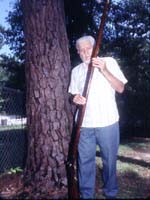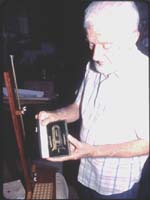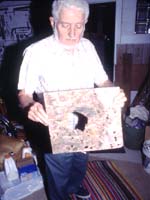
|
Features
|
|
|
|
Books
|
|
|
|
Fun & Games
|
|
|
|
Contact Us
|
|
|
Night Hawk Stories... Entry 8
Where Wilson Got His 75-millimeter Cannon
 EDITOR'S
NOTE: Jerome Wilson, a master machinist and one of the last real craftsmen
left in our society, has built black-powder rifles since 1943. Wilson
handcrafts all of his weapons, even making his own screws and springs.
More important than the time Wilson spends in building a rifle or any
other piece of machinery, is the attention to quality he puts into whatever
project he starts. He invests time and money into building a gun or a
cannon by finding the right barrel, going through stacks of lumber to
find just the right curly maple for the stock and completing the tedious
task of making each individual screw and spring. Wilson doesn't stop with
building a highly accurate black-powder weapon. He also wants his guns
to have style and beauty. He demonstrates this in the engraving and silver
decorations that he carefully cuts and embeds in his stocks. Although
Wilson doesn't sell his rifles, they stay in high demand because of the
loving care and intricate woodwork and metalwork put into each one.
EDITOR'S
NOTE: Jerome Wilson, a master machinist and one of the last real craftsmen
left in our society, has built black-powder rifles since 1943. Wilson
handcrafts all of his weapons, even making his own screws and springs.
More important than the time Wilson spends in building a rifle or any
other piece of machinery, is the attention to quality he puts into whatever
project he starts. He invests time and money into building a gun or a
cannon by finding the right barrel, going through stacks of lumber to
find just the right curly maple for the stock and completing the tedious
task of making each individual screw and spring. Wilson doesn't stop with
building a highly accurate black-powder weapon. He also wants his guns
to have style and beauty. He demonstrates this in the engraving and silver
decorations that he carefully cuts and embeds in his stocks. Although
Wilson doesn't sell his rifles, they stay in high demand because of the
loving care and intricate woodwork and metalwork put into each one.
QUESTION: Where did you get your 75-millimeter cannon? ANSWER: Well, I always wanted a cannon, but buying a 75-millimeter cannon cost about $5,000. I knew that if I wanted one, I would have to build it myself. So, one day I went the scrap yards in Charleston, South Carolina. In one scrap yard, I found cannon barrels that came from decommissioned war ships piled high in an area about two football fields long. I picked out the size I wanted, and the scrap yard cut off a piece of cannon barrel with a cutting torch. The ordinate steel barrel was already drilled, rifled and capable of holding 250,000 pounds of pressure without blowing up.
 QUESTION:
Where did you get the wheels on your cannon? ANSWER: I used the tail wheels
off a Brewster Buffalo Navy fighter. These planes became extinct after
the Battle of Midway on June 4, 1942. All those planes were shot down
in the marine squadron.
QUESTION:
Where did you get the wheels on your cannon? ANSWER: I used the tail wheels
off a Brewster Buffalo Navy fighter. These planes became extinct after
the Battle of Midway on June 4, 1942. All those planes were shot down
in the marine squadron.
QUESTION: How many grains of powder do you use to load
your cannon?
ANSWER: I use 250 grains of black powder.
QUESTION: What else do you shoot out of your cannon besides
oranges?
ANSWER: We shoot baseballs, pool balls and anything else that will fit
down the hole.
QUESTION: How did you make the cannon sight?
ANSWER: I took a flat piece of brass, sawed it out, milled it and indexed
it.
QUESTION: What kind of accuracy does the sight have? ANSWER: Oh, it's pretty accurate. I have three different size sight pins that I use for the front sight. For longer ranges I use shorter sights. This way, I don't have to move the elevation screws so much.
 QUESTION:
How often do you shoot your cannon?
QUESTION:
How often do you shoot your cannon?
ANSWER: We shoot the cannon every three years when we have the state black-powder
championships at the South Carolina Po' Boys Muzzleloading Club, which
is headquartered at my place. (See last week's web page info to learn
more about this muzzleloading club.) Sometimes in the summer we take youngsters
out to the range to let them shoot oranges out of the cannon.
Talk to Wilson about old rifles and how he handcrafts them by contacting him at 812 Water Street, Allendale, South Carolina 29810, or calling 803-584-3163.
To learn more about CVA's quality black-powder weapons and hunting accessories, call (770) 449-4687; e-mail cva@info.com; or, see the CVA catalogue online.
Tomorrow: Other Guns Wilson Has Built
Entry 06 -Wilson's History
of Gunmaking
Entry 07 -Wilson's Cannon
Entry 08 -Where Wilson Got His 75-millimeter
Cannon
Entry 09 -Other Guns Wilson Has Built
Entry 10 -Wilson's Labor of Love